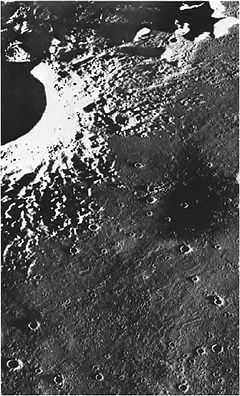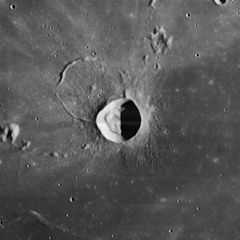Lichtenberg (crater)
|
Lunar Orbiter 4 image | |
| Coordinates | 31°48′N 67°42′W / 31.8°N 67.7°WCoordinates: 31°48′N 67°42′W / 31.8°N 67.7°W |
|---|---|
| Diameter | 20 km |
| Depth | 1.2 km |
| Colongitude | 68° at sunrise |
| Eponym | Georg C. Lichtenberg |

Lichtenberg is an isolated lunar crater located in the western part of the Oceanus Procellarum. The nearest crater of note is Briggs to the south.
Lichtenberg has a small system of rays, a characteristic of Copernican age craters. The rays extend to the north and west of the crater but not elsewhere. The remaining flanks of the surface about the crater exhibit the low albedo of the lunar mare, and the mare deposits have overlaid the existing rays on the east and south sides of the crater. These are thus among the youngest deposits of basaltic lava on the Moon, and are believed to be less than 1 billion years in age.[1] Lunar scientist Paul Spudis advocates an unmanned sample-return mission to the young mare to obtain an absolute radiometric date that would constrain the time period of the formation of the maria on the moon.[2]
The rim of this crater is circular and sharp-edged, with negligible wear. On the inner sides the loose material has slid to the base, forming a ring of scree about the interior floor. Both the rim and the interior floor exhibit a relatively high albedo, which is usually an indication of a younger crater that has not been darkened by space weathering. Lichtenberg overlies a larger, ring-shaped ghost crater to the northwest, which has a low central rise. This feature is covered by ray material.
Lichtenberg has been noted in the past for occurrences of transient lunar phenomenon. These typically take the form of a temporary, red-hued patch.
Satellite craters
By convention these features are identified on lunar maps by placing the letter on the side of the crater midpoint that is closest to Lichtenberg.
| Lichtenberg | Latitude | Longitude | Diameter |
|---|---|---|---|
| A | 29.0° N | 60.1° W | 7 km |
| B | 33.3° N | 61.5° W | 5 km |
| F | 33.2° N | 65.3° W | 5 km |
| H | 31.5° N | 58.9° W | 4 km |
| R | 34.7° N | 70.2° W | 34 km |
The following craters have been renamed by the IAU.
- Lichtenberg G — See Humason (crater).
References
- Andersson, L. E.; Whitaker, E. A. (1982). NASA Catalogue of Lunar Nomenclature. NASA RP-1097.
- Blue, Jennifer (July 25, 2007). "Gazetteer of Planetary Nomenclature". USGS. Retrieved 2007-08-05.
- Bussey, B.; Spudis, P. (2004). The Clementine Atlas of the Moon. New York: Cambridge University Press. ISBN 978-0-521-81528-4.
- Cocks, Elijah E.; Cocks, Josiah C. (1995). Who's Who on the Moon: A Biographical Dictionary of Lunar Nomenclature. Tudor Publishers. ISBN 978-0-936389-27-1.
- McDowell, Jonathan (July 15, 2007). "Lunar Nomenclature". Jonathan's Space Report. Retrieved 2007-10-24.
- Menzel, D. H.; Minnaert, M.; Levin, B.; Dollfus, A.; Bell, B. (1971). "Report on Lunar Nomenclature by the Working Group of Commission 17 of the IAU". Space Science Reviews 12 (2): 136–186. Bibcode:1971SSRv...12..136M. doi:10.1007/BF00171763.
- Moore, Patrick (2001). On the Moon. Sterling Publishing Co. ISBN 978-0-304-35469-6.
- Price, Fred W. (1988). The Moon Observer's Handbook. Cambridge University Press. ISBN 978-0-521-33500-3.
- Rükl, Antonín (1990). Atlas of the Moon. Kalmbach Books. ISBN 978-0-913135-17-4.
- Webb, Rev. T. W. (1962). Celestial Objects for Common Telescopes (6th revision ed.). Dover. ISBN 978-0-486-20917-3.
- Whitaker, Ewen A. (1999). Mapping and Naming the Moon. Cambridge University Press. ISBN 978-0-521-62248-6.
- Wlasuk, Peter T. (2000). Observing the Moon. Springer. ISBN 978-1-85233-193-1.
External links
- "Crater Lichtenberg and young lunar basalts tracked by SMART-1". ESA. Retrieved 2006-03-31.
